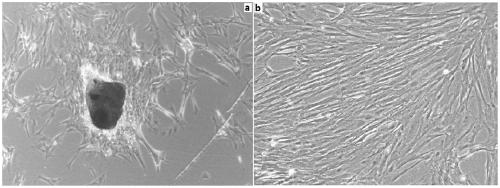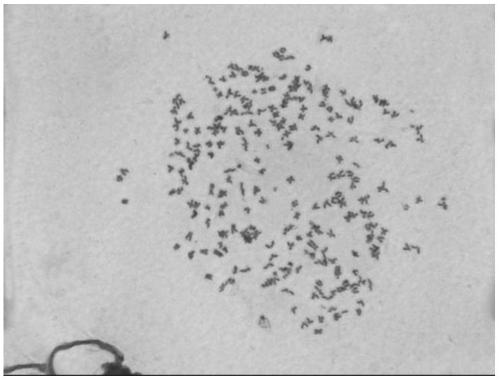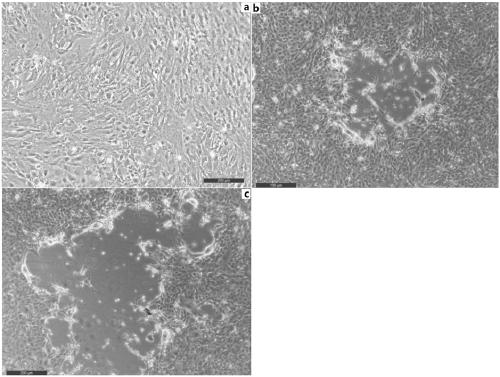Spinal cord tissue cell lines of Carassius auratus gibelio and construction method and application thereof
A technology of heterotrophic silver crucian carp and tissue cells, applied in cell dissociation methods, artificial cell constructs, bone/connective tissue cells, etc. Lesion effect stable effect
- Summary
- Abstract
- Description
- Claims
- Application Information
AI Technical Summary
Problems solved by technology
Method used
Image
Examples
Embodiment 1
[0039] The establishment of heterogeneous gibel carp spinal cord tissue cell line, its steps are as follows:
[0040] (1) Treatment of spinal cord tissue: take out the spinal cord tissue of heterogeneous gibel crucian carp under aseptic conditions, and the aseptic treatment is 30-60mm 3 Put the tissue block into the culture dish containing L15 culture medium;
[0041] (2) Primary culture: Put the tissue pieces in step (1) evenly into a T25 cell culture bottle, with the side of the tissue pieces facing up, add 3ml of culture medium to the culture bottle, overnight, and slowly dissolve the culture bottle Turn it sideways to make the tissue block soak in the culture medium, and then turn the side with the tissue block up, and operate it once from time to time until cells grow out of the edge of the tissue block, place the cell culture bottle upright for culture, and replace the culture medium every 2 to 3 days Once; the morphology of primary cells and passage cells are as follow...
Embodiment 2
[0047] The biological characteristics of CSC of the allogenic gibel carp spinal cord tissue cell line:
[0048] (1) Morphology: The cell type was fibroblast-like cells.
[0049] (2) Growth characteristics: The subcultured CSC cells began to adhere to the wall after 30 minutes, and completely adhered to the wall after 6 hours; the population doubling time was 48 hours.
[0050] (3) Stability: The heterogeneous gibel crucian carp spinal cord tissue cell line CSC has been propagated to 42 passages before the application date, and the proliferation is stable.
[0051] (4) Cryopreservation and recovery:
[0052] After thawing, CSC cells adhered to the wall quickly, and their growth morphology and conditions were basically similar to those of cells that had not been frozen, with no significant difference. The revived cells were stained with trypan blue, and about (78.56±6.10)% of the cells were not stained and had cell viability through statistical counting of the cells.
[0053]...
Embodiment 3
[0056] The application of heterogeneous gibel crucian carp spinal cord tissue cell line, its process is as follows:
[0057] (1) Collection and processing of infected carp herpes virus type Ⅱ disease materials:
[0058] Collect the kidney, spleen, brain and spinal cord tissues of freshly dead fish infected with carp herpesvirus type Ⅱ, cut them into pieces, add an equal volume of PBS to homogenate, centrifuge at 5000rpm at 4°C for 15min, and filter through a 0.22μm filter membrane to prepare sterile tissue homogenate , stored at -80°C after aliquoting;
[0059] (2) Proliferation of carp herpesvirus type Ⅱ in CSC:
[0060] After the CSC is cultured to about 80% of the cell monolayer, discard the medium and wash it twice with serum-free cell maintenance solution, inoculate 0.2ml of the supernatant of the above-mentioned disease tissue homogenate on the CSC cell monolayer, and keep at 24°C Adsorb for 1 hour, during which time the flask was shaken slightly every 15-20 minutes fo...
PUM
 Login to View More
Login to View More Abstract
Description
Claims
Application Information
 Login to View More
Login to View More - R&D
- Intellectual Property
- Life Sciences
- Materials
- Tech Scout
- Unparalleled Data Quality
- Higher Quality Content
- 60% Fewer Hallucinations
Browse by: Latest US Patents, China's latest patents, Technical Efficacy Thesaurus, Application Domain, Technology Topic, Popular Technical Reports.
© 2025 PatSnap. All rights reserved.Legal|Privacy policy|Modern Slavery Act Transparency Statement|Sitemap|About US| Contact US: help@patsnap.com



